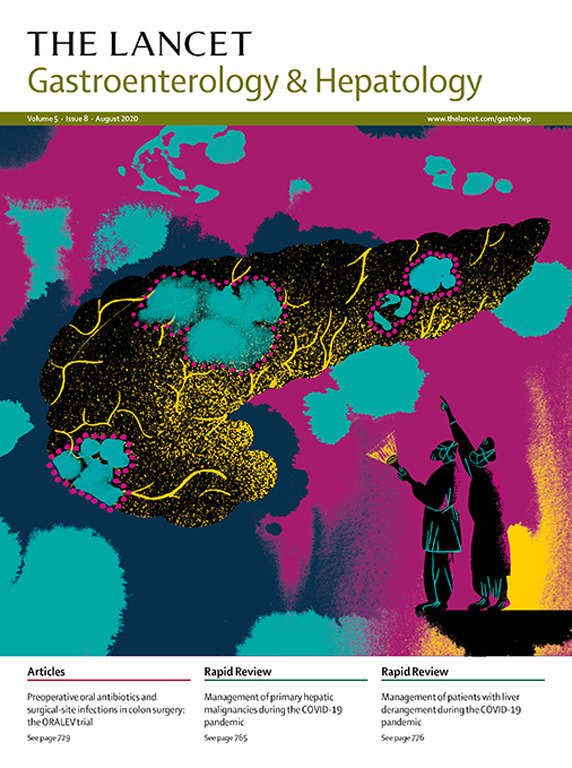Antibiotic treatment versus appendicectomy for acute appendicitis in adults: an individual patient data meta-analysis
IF 30.9
1区 医学
Q1 GASTROENTEROLOGY & HEPATOLOGY
引用次数: 0
Abstract
Background
Randomised controlled trials (RCTs) have found antibiotics to be a feasible and safe alternative to appendicectomy in adults with imaging-confirmed acute appendicitis. However, patient inclusion criteria and outcome definitions vary greatly between RCTs. We aimed to compare antibiotics with appendicectomy for the treatment of acute appendicitis using individual patient data and uniform outcome definitions.Methods
In this individual patient data meta-analysis, we searched PubMed, Embase, and the Cochrane Central Register of Controlled Trials without language restrictions between database inception and June 6, 2023, for RCTs comparing appendicectomy with antibiotics for the treatment of adults (≥18 years) with imaging-confirmed acute appendicitis. Studies without 1-year follow-up data on complications were excluded, as were patients. Corresponding authors of eligible studies were contacted and invited to share data; individual patient data were merged after validation. One-stage meta-analyses were conducted using a generalised, mixed-effects linear regression model, accounting for clustering of patients within studies. The primary outcome was the complication rate at 1-year follow-up, uniformly harmonised across trials using the Clavien–Dindo classification. Complications were further divided into minor (grade 1–2 or equivalent) and major (grade 3–5 or equivalent) complications. Appendicectomy rate during 1 year was a key secondary outcome but not considered a complication for the antibiotics group. Outcomes were described separately for patients with and without an appendicolith. This study is registered with PROSPERO, CRD42023391676.Findings
Of 887 potentially relevant articles, eight were eligible for inclusion, of which six RCTs could provide data for 2101 eligible patients (1050 assigned to antibiotics and 1051 assigned to appendicectomy; 830 [39·5%] women and 1271 [60·5%] men). All studies raised some bias concerns due to absence of blinding. One study was judged to have a high risk of bias due to the exclusion of eligible patients after randomisation, but these patients were eligible for inclusion in our meta-analysis. At 1 year, 57 (5·4%) of 1050 patients randomly assigned to antibiotics had a complication compared with 87 (8·3%) of 1051 patients randomly assigned to appendicectomy (odds ratio [OR] 0·49 [95% CI 0·20 to 1·20]; risk difference –4·5 percentage points [95% CI –11·6 to 2·6]). At 1 year, 1025 (97·5%) patients in the appendicectomy group had undergone appendicectomy compared with 356 (33·9%) patients in the antibiotics group. In patients with an appendicolith at pre-interventional imaging, there were more complications at 1 year among patients who received antibiotic treatment than among those who underwent appendicectomy (29 [15·0%] of 193 patients vs 12 [6·3%] of 190 patients; OR 2·82 [95% CI 1·11 to 7·18]; risk difference 13·2 percentage points [95% CI 2·3 to 24·2]). In the antibiotics group, 94 (48·7%) of 193 patients with an appendicolith underwent appendicectomy within 1 year versus 262 (30·6%) of 857 patients without an appendicolith.Interpretation
This meta-analysis showed that antibiotic treatment in adults with imaging-confirmed acute appendicitis was a safe alternative to surgery and resulted in around two-thirds of patients avoiding appendicectomy during the first year. In patients with an appendicolith, initial antibiotic treatment increased the risk of complications compared with appendicectomy, and around half of these patients assigned to antibiotics underwent step-up appendicectomy within 1 year. These data should be key components in shared decision making.Funding
None.抗生素治疗与阑尾切除术治疗成人急性阑尾炎:个体患者数据荟萃分析
随机对照试验(RCTs)发现,对于影像学证实的急性阑尾炎患者,抗生素是阑尾切除术的一种可行且安全的替代方法。然而,不同随机对照试验的患者纳入标准和结果定义差异很大。我们的目的是比较抗生素与阑尾切除术治疗急性阑尾炎的个体患者数据和统一的结果定义。方法在这项个体患者数据荟萃分析中,我们检索了PubMed、Embase和Cochrane中央对照试验注册库(无语言限制),从数据库建立到2023年6月6日,比较阑尾切除术与抗生素治疗影像学确诊急性阑尾炎成人(≥18岁)的随机对照试验。没有1年并发症随访数据的研究和患者被排除在外。联系符合条件的研究的通讯作者并邀请其分享数据;验证后合并个体患者数据。采用广义混合效应线性回归模型进行单阶段荟萃分析,考虑研究中患者的聚类。主要结果是1年随访时的并发症发生率,使用Clavien-Dindo分类统一协调各试验。并发症进一步分为轻微(1-2级或相当)和严重(3-5级或相当)并发症。1年内阑尾切除术率是一个关键的次要结局,但不被认为是抗生素组的并发症。有阑尾结石和没有阑尾结石的患者分别描述了结果。本研究注册号为普洛斯彼罗,CRD42023391676。在887篇可能相关的文章中,8篇符合纳入条件,其中6篇rct可提供2101例符合条件的患者的数据(1050例分配给抗生素,1051例分配给阑尾切除术;830名(39.5%)女性和1271名(65%)男性)。由于缺乏盲法,所有研究都提出了一些偏倚问题。由于随机化后排除了符合条件的患者,一项研究被判断为具有高偏倚风险,但这些患者有资格纳入我们的荟萃分析。1年时,随机分配给1050例抗生素患者中有57例(5.4%)出现并发症,而随机分配给1051例阑尾切除术患者中有87例(8.3%)出现并发症(优势比[OR] 0.49 [95% CI 0.20至1.20];风险差异- 4.5个百分点[95% CI - 11.6 ~ 2.6])。1年时,阑尾切除术组有1025例(97.5%)患者行阑尾切除术,抗生素组有356例(33.9%)患者行阑尾切除术。在介入前成像发现阑尾结石的患者中,接受抗生素治疗的患者1年并发症发生率高于阑尾切除术患者(193例患者中有29例[15.0%]vs 190例患者中有12例[6.3%]);OR 2.82 [95% CI 1.11 ~ 7.18];风险差异13.2个百分点[95% CI 2.3 ~ 24.2])。在抗生素组,193例有阑尾的患者中有94例(48.7%)在1年内行阑尾切除术,而857例无阑尾的患者中有262例(30.6%)在1年内行阑尾切除术。本荟萃分析显示,对于影像学确诊的急性阑尾炎患者,抗生素治疗是手术的安全选择,并导致约三分之二的患者在第一年避免阑尾切除术。在阑尾炎患者中,与阑尾切除术相比,最初的抗生素治疗增加了并发症的风险,这些患者中约有一半在1年内接受了进一步的阑尾切除术。这些数据应该是共同决策的关键组成部分。
本文章由计算机程序翻译,如有差异,请以英文原文为准。
求助全文
约1分钟内获得全文
求助全文
来源期刊

Lancet Gastroenterology & Hepatology
Medicine-Hepatology
CiteScore
50.30
自引率
1.10%
发文量
0
期刊介绍:
The Lancet Gastroenterology & Hepatology is an authoritative forum for key opinion leaders across medicine, government, and health systems to influence clinical practice, explore global policy, and inform constructive, positive change worldwide.
The Lancet Gastroenterology & Hepatology publishes papers that reflect the rich variety of ongoing clinical research in these fields, especially in the areas of inflammatory bowel diseases, NAFLD and NASH, functional gastrointestinal disorders, digestive cancers, and viral hepatitis.
 求助内容:
求助内容: 应助结果提醒方式:
应助结果提醒方式:


